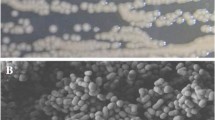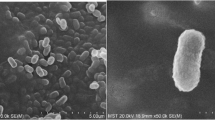Abstract
A novel strain of Micrococcus sp. DUT_AHX, which was isolated from the sludge of a nitrobenzene (NB)-manufacturing plant and could utilize NB as the sole carbon source, was identified on the basis of physiological and biochemical tests and 16S ribosomal DNA (rDNA) sequence analysis. It can grow at the temperature up to 40 °C or in the presence of NaCl concentration up to 12 g/L in Luria-Bertani (LB) medium. The optimal degradation conditions are as follows: temperature 37 °C, pH 7.0, and shaking speed 150 r/min. The strain involves a partial reductive pathway due to the release of ammonia and can also utilize 2-aminophenol as the sole carbon source. Furthermore, the enzyme activity tests show that crude extracts of NB-grown strain DUT_AHX mainly contain 2-aminophenol 1, 6-dioxygenase activity. The exploitation of salt-tolerant bacteria will be a remarkable improvement in NB bioremediation and wastewater treatment at high salinity and high temperature.
Similar content being viewed by others
References
KEITH L H, TELLIARD W A. Priority pollutants (I): A perspective view [J]. Environmental Science Technology, 1979, 13(4): 416–423.
de BAERE L A, DEVOCHT M, ASSCHE P V, VERSTRAETE W. Influence of high NaCl and NH4Cl salt levels on methanogenic associations [J]. Water Research, 1984, 18(5): 543–648.
NISHINO S F, SPAIN J C. Degradation of nitrobenzene by a Pseudomonas pseudoalcaligenes [J]. Applied Environmental Microbiology, 1993, 59(8): 2520–2525.
PARK H S, LIM S J, CHANG Y K, LIVINGSTON A G, KIM H S. Degradation of chloronitrobenzenes by a coculture of Pseudomonas putida and Rhodococcus sp. [J]. Applied Environmental Microbiology, 1999, 65(3): 1083–1091.
ZHEN Da, LIU Hong, WANG Shu-jun, ZHANG Jun-jie, ZHAO Fei, ZHOU Ning-yi. Plasmid-mediated degradation of 4-chloronitrobenzene by newly isolated Pseudomonas putida strain ZWL73 [J]. Applied Environmental Microbiology, 2006, 72(4):797–803.
NISHINO S F, SPAIN J C. Oxidative pathway for the biodegradation of nitrobenzene by Comamonas sp. strain JS765 [J]. Applied Environmental Microbiology, 1995, 61(6): 2308–2313.
WU Jian-feng, SUN Cui-wei, JIANG Cheng-ying, LIU Zhi-pei, LIU Shuang-jiang. A novel 2-aminophenol 1, 6-dioxygenase involved in the degradation of p-chloronitrobenzene by Comamonas strain CNB-1: Purification, properties, genetic cloning and expression in Escherichia coli [J]. Archives of Microbiology, 2005, 183(1): 1–8.
BUCHANAN R E, GIBBONS N E. Bergey’s manual of systematic bacteriology [M]. 8th ed. Baltimore: Williams and Wilkins, 1984.
SAMBROOK J, RUSSELL D W. Molecular cloning: A laboratory manual [M]. 3rd ed. New York: Cold Spring Harbor Laboratory Press, 2001.
MARMUR J, DOTY P. Determination of the base composition of deoxyribonucleic acid from thermal denaturation temperature [J]. Journal Molecular Biology, 1962, 5: 109–118.
ZHOU Hong-bo, LIU Xi, FU Bo, QIU Guan-zhou, HUO Qiang, ZENG Wei-min, LIU Jian-she, CHEN Xin-hua. Isolation and characterization of Acidithiobacillus caldus from several typical environments in China [J]. Journal of Central South University of Technology, 2007, 14(2): 163–169.
YANG Yu, DIAO Meng-xue, SHI Wu-yang, LI Li, DAI Qin-yun, QIU Guan-zhou. Isolation and characterization of organic-sulfur degradation bacterial strain [J]. Journal of Central South University of Technology, 2007, 14(3): 324–329.
LIU Jian-she, XIE Xue-hui, XIAO Sheng-mu, WANG Xiu-mei, ZHAO Wen-jie, TIAN Zhuo-li. Isolation of Leptospirillum ferriphilum by single-layered solid medium [J]. Journal of Central South University of Technology, 2007, 14(4): 467–473.
KUMAR S, TAMURA K, NEI M. MEGA3: Integrated software for molecular evolutionary genetics analysis and sequence alignment [J]. Briefings in Bioinformatics, 2004, 5(2): 150–163.
SCHRAA G, BOONE M L, JETTEN M S M, van NEERVEN A R W, COLBERG P J, ZEHNDER A J B. Degradation of 1, 4-dichlorobenzene by Alcaligenes sp. strain A175 [J]. Applied Environmental Microbiology, 1986, 52(6): 1374–1381.
GERHARDT P, MURRAY R G, WOOD W A, KRIEG N R. Methods for general and molecular bacteriology [M]. Washington: American Society for Microbiology, 1994.
BRADFORD M M. A rapid and sensitive method for the quantitation of microgram quantities of protein utilizing the principle of protein-dye binding [J]. Analytical Biochemistry, 1976, 72(1/2): 248–254.
VREELAND R H. Mechanisms of halotolerance in microorganisms [J]. Critical Reviews Microbiology, 1987, 14(4): 311–356.
DUCHÉ O, TRÉMOULET F, GLASER P, LABADIE J. Salt stress proteins induced in Listeria monocytogenes [J]. Applied Environmental Microbiology, 2002, 68(4): 1491–1498.
Author information
Authors and Affiliations
Corresponding author
Rights and permissions
About this article
Cite this article
Ai, Hx., Zhou, Jt. & Lü, H. A novel salt-tolerant Micrococcus sp. DUT_AHX capable of degrading nitrobenzene. J. Cent. South Univ. Technol. 16, 230–235 (2009). https://doi.org/10.1007/s11771-009-0039-x
Received:
Accepted:
Published:
Issue Date:
DOI: https://doi.org/10.1007/s11771-009-0039-x




